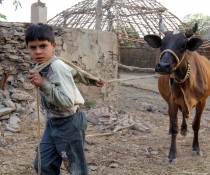
Exploring the Gujar village was a fantastic, once-in-a-lifetime experience. Just as the heat began to fade, we loaded ourselves into a bus and drove ten minutes down the road, where we turned onto a dirt path leading to the Gujar village. The people there had migrated to the foothills of the Himalayas during the Mughal Empire to escape forced conversion to Islam, and their lifestyle has largely stayed intact.
They earn their income from selling buffalo milk. It is the most expensive milk in the area because their buffalo graze on untouched land. Besides the men riding their bikes to the main road to exchange their milk, they have virtually no contact with the outside world. Seeing the way they live was amazing; their houses are constructed of dead wood frames and wheat packed with clay. The roofs let out the smoke without leaking when it rains. The triangular and circular windows painted with faded colors were beautiful. They made their own rope to construct beds that looked more comfortable than hammocks and used coal irons for their clothes.
The dry forest landscape they call home was much more barren than I had expected. The heat left the area normally occupied by the Ganges River dry and dusty, with random patches of green trees and shrubs. Yet somehow, the Gujar people manage to live a more efficient and environmentally friendly lifestyle than most of the world. They use only dead wood to fuel their fires, live in clay huts which stay warm in winter and cold in summer, barely use the solar lights they have, are highly conservative with water, use as much from their livestock as they can, and generally work with the land rather than against it. Exploring their village was both eye opening and humbling. I feel grateful to have been given the opportunity to experience something so pure and simple that contrasts so greatly with the kind of life I’m familiar with.


Hi Susie,
I appreciate your vivid descriptions and insightful observations. There are few relatively “untouched” cultures and groups that still exist on this world, and I think it’s amazing that you had a chance to meet and experience one…even a little. What a contrast from our familiar culture. I appreciate the point you make about how sustainable and environmentally-friendly their lifestyle is…without the hoopla of “we’re green”…they just are naturally assuming and pursuing a path that is functional and sustainable given the opportunities and choices available to them.
If only humanity could make similar functional and environmentally-harmonius choices on a more global scale…
Thanks for writing about this! I had never heard of these people before and appreciate learning of their existence and culture – and that you shared some personal observations.
Take Care, Leigh Ann